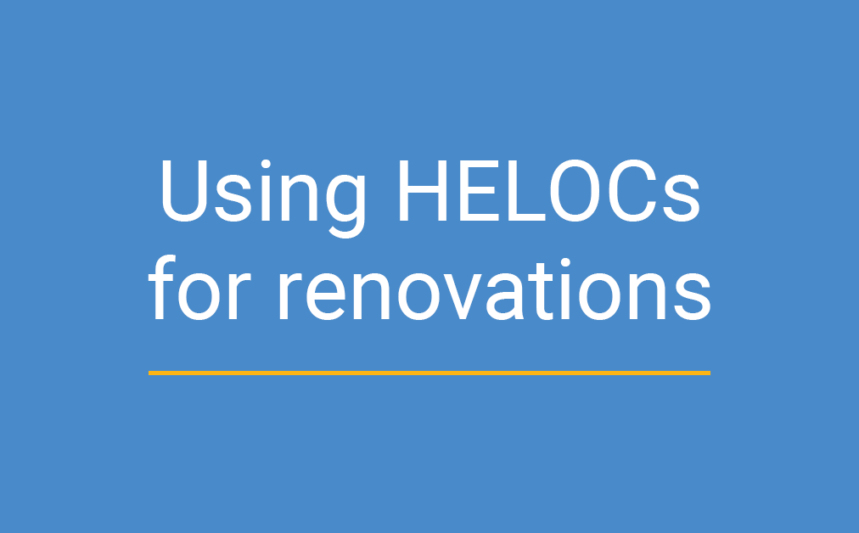If you qualify for a Home Equity Line of Credit (HELOC), using a HELOC for home improvement can be a smart financial alternative to dipping into your savings. From creating your dream home to increasing its value before selling the property, it can be a great idea to use a HELOC for home renovations.
Your team at Liberty Bay is here to help you decide if a HELOC is right for your needs and understand the best ways to use a HELOC for home improvement.
In this article:
- How do HELOCs work?
- HELOCs vs. home equity loans
- Benefits and drawbacks of HELOCs for home improvement projects
- What home improvement projects could you fund with a HELOC?
How do HELOCs work?
A HELOC is a revolving credit line that works sort of like a credit card. You can draw from your HELOC up to a maximum credit limit set by your lender, which is usually 80% or less of the equity you currently have in your home. Your home’s equity is equal to its market value minus the amount you owe on the mortgage.
Depending on your lender, you will have to meet a few requirements to qualify for a HELOC, such as available equity, proof of steady income, solid credit, and a low enough debt-to-income ratio. Once you are approved for a HELOC, you will enter a draw period followed by a repayment period.
HELOC draw period
During your draw period, you can use your line of credit as much as you want up to your borrowing limit. You can access your funds online, and some lenders will provide you with a credit card connected to your HELOC account. As with any line of credit, you only pay for what you borrow, so your monthly payments will have varying required minimum payments.
You may have the option to pay interest only, but you can also pay your principal or any outstanding balance to pay the loan off sooner. Draw periods typically last about ten years. Once the draw period expires, your repayment period begins.
HELOC repayment period
After the draw period, you will no longer be able to access or withdraw funds from your HELOC. This next phase is called the repayment period, during which you must start paying back the entire loan and any accrued interest.
Your monthly payments will likely be higher during your repayment period because you will be paying back more principal. The repayment period usually lasts around 15 years.
What makes a HELOC different from a home equity loan?
While a HELOC is a revolving line of credit, a home equity loan is a one-time loan. It provides one lump sum for you to use and repay. Home equity loans usually have higher interest rates, but they also provide the stability of a fixed-term with equal monthly payments.
Consider some of the benefits and drawbacks of a HELOC to help you decide which home equity product is best for you.
Benefits of using a HELOC for home renovations
You have some more freedom and flexibility with a HELOC compared to a home equity loan. If you’re not sure how much money you’ll need, or you want to be able to tap into your line of credit at any time, a HELOC may be the answer. Other benefits include:
- Tax-deductible interest: this applies to both home equity products. If you’re using the funds to improve the home from which you borrowed equity, you may be able to write off some or all of the interest on your tax return.
- Low interest rates: while both HELOCs and home equity loans often come with relatively low interest rates, HELOCs often have lower introductory rates than home equity loans. Keep in mind, however, that these rates are variable.
- Interest-only period: during the draw phase of your HELOC, you may have the option to make interest-only payments. This option helps keep your monthly payments low and manageable.
- Flexibility and accessibility: you can borrow as much or as little of your HELOC as you need, as often as you need it during your draw period. This flexibility to use and pay off the same pool of money repeatedly can be a great advantage.
- Increase your home value: if you’re planning to sell your property, using a HELOC to invest in your home may help you sell more quickly and for more money, giving you an immediate return on your investment.
Whether you’re looking to renovate your dream home or turn a profit by selling your house, a great way to achieve your goals can be using your HELOC for home improvement! However, ensure you also consider some of the potential drawbacks of a HELOC.
Drawbacks of using a HELOC for home improvement
Every financial product comes with pros and cons to consider. If you’re deciding whether a HELOC is right for you, don’t forget to consider the following:
- Variable rates: the interest you need to pay on your HELOC can fluctuate, which may affect your monthly payments. Check your HELOC agreement for the maximum potential interest rate you could be expected to pay.
- Balloon payments: some HELOCs require a balloon payment at the end of the draw period. If a significant lump sum will be a challenge for you to pay, a HELOC may not be the answer.
- Responsible borrowing: your HELOC comes with a high-limit open line of credit, which can make overspending tempting. Ensure you don’t take on more debt than you can afford!
- Market changes: the real estate market isn’t always easy to predict. If your home value changes dramatically, you may end up owing more than your home is worth, or your lender may reduce your HELOC’s limit.
- Timing: getting approved for a HELOC may take longer than it would for a loan. If you need funds urgently for a project, this timing may not work for your plans.
One final consideration is that new homeowners may not have enough equity to qualify for a high enough HELOC limit for your plans. If you bought your home recently and still owe a significant amount on your mortgage, consider if your borrowing limit will be sufficient for you to use your HELOC for home improvement.
What home improvement projects could you fund with a HELOC?
You’ve considered the benefits. You’ve considered the drawbacks. Now, you’re ready to start planning to use your HELOC for home improvement. Renovations can be expensive, but using your HELOC to tackle your renovation wishlist can considerably improve your home’s value. So, where should you start?
Remodeling Magazine’s 2022 Cost vs. Value report offers some great insights regarding which projects to start with, especially if your end goal is to sell the house. Minor improvements such as garage door replacement and small kitchen remodels can add significant resale value to your home and help you recoup a substantial percentage of the job cost.
If your goal is to touch up your house and turn it into your dream home, start by asking yourself a few basic questions:
- What does your house need? Some projects are not just nice-to-haves; they can make your home more comfortable or even more efficient. Consider long-lasting home improvements that can also improve your quality of life.
- What’s most important in your home? If you like to host guests, maybe adding a deck is a good idea. If you work from home, improving your home office might be a priority. Take your lifestyle and personal preferences into consideration!
- What are the costliest items on your list? Depending on your borrowing terms, starting with a high-cost project to take advantage of interest-only periods and low interest rates might be a good strategy.
Whatever you decide to tackle first, be sure to talk to experienced lenders who can help you secure the best terms for your HELOC. At Liberty Bay, our priority is putting your needs first to create exceptional experiences and give you the tools you need to achieve your goals.
We hope this guide was a helpful place to start thinking about using your HELOC funds for home improvement projects! If you have more questions or are ready to talk to us about applying for a HELOC, get in touch with our experts anytime.


